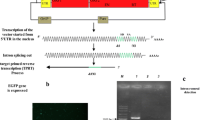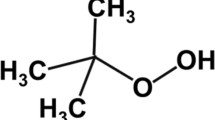Abstract
In previous laboratory and environmental studies, the Ty1 short-term test showed positive responses (i.e. induced mobility of the Ty1 retrotransposon) to carcinogenic genotoxins. Here, we provide evidence for a causal relationship between increased level of reactive oxygen species and induction the mobility of the Ty1 retrotransposon. Results obtained in concentration and time-dependent experiments after treatment, the tester cells with carcinogenic genotoxins [benzo(a)pyrene, benzo(a)anthracene, ethylmethanesulfonate, formamide], free bile acids (chenodeoxycholic, lithocholic acids) and metals (arsenic, hexavelant chromium, lead) showed a simultaneous increase in both cellular level of the superoxide anions and Ty1 retrotransposition rates. Treatment with the noncarcinogenic genotoxins [benzo(e)pyrene, benzo(b)anthracen, anthracene], conjugated bile acids (taurodeoxycholic, glycodeoxycholic acids) and metals (zinc, trivalent chromium) did not change significantly superoxide anions level and Ty1 retrotransposition rate. The induction by carcinogens of the Ty1 mobility seems to depend on the accumulation of superoxide anions, since the addition of the scavenger N-acetylcysteine resulted in loss of both increased amount of superoxide anions and induced Ty1 retrotransposition. Increased hydrogen peroxide levels are also involved in the induction of Ty1 retrotransposition rates in response to treatment with carcinogenic genotoxins, as evidenced by disruption of YAP1 gene in the tester cells. It is concluded that the carcinogen-induced high level of reactive oxygen species play a primary and key role in determination the selective response of Ty1 test to carcinogenic genotoxins.
Similar content being viewed by others
References
Bernstein H, Bernstein C, Payne CM, Dvorekova K, Garewall H (2005) Bile acids as carcinogens in human gastrointestinal cancers. Mutat Res 589:47–65
Bertram JS (2001) The molecular genetics of carcinogenesis. Mol Aspect Med 21:167–223
Bohr VA (2002) Repair of oxidative DNA damage in nuclear and mitochondrial DNA and some changes with aging in mammalian cells. Free Radic Biol Med 32:804–812
Curcio JM, Garfinkel DG (1991) Single step selection for Ty1 element retrotransposition. Proc Natl Acad Sci USA 88:936–940
Dillon CT, Lay PA, Bonin AM, Cholewa M, Legge GJF (2000) Permeability, cytotoxicity and genotoxicity and some Cr(VI) analogues in V79 Chinese Hamster Lung cells. Chem Res Toxicol 13:742–748
Donkin SG, Ohlson DL, Teaf CM (2000) Properties and effects of metals. In: Williams PL, James RC, Roberts SM (eds) Principles of toxicology: environmental and industrial applications, 2nd edn. John Wiley, London, pp 325–345
Drake JW (1970) The molecular basis of mutation. Holden Day, Oakland
Eastmond DA, Macgregor JT, Slesinski RS (2008) Trivalent chromium: assessing the genotoxic risk of an essential trace element and widely used human and animal nutritional supplement. Crit Rev Toxicol 38:173–190
Fu J, Liang X, Chen Y, Tang L, Zhang Q, Dong Q (2008) Oxidative stress as a component of chromium-induced cytotoxicity in rat calvarial osteoblasts. Cell Biol Toxicol 24:201–212
Garfinkel D (1992) Retroelements in microorganisms. In: Levy JA (ed) Retroviritidae. Plenum Press, New York, pp 107–136
Gitan M, Shababi M, Kramer M, Eide DJ (2003) A cytosolic domain of the yeast Ztr1 zinc transporter is required for its post translational inactivation in response to zinc and cadmium. J Biol Chem 278:39558–39564
Herrero E, Ros J, Belli G, Cabiscol E (2008) Redox control and oxidative stress in yeast cells. Biochim Biophys Acta 1780:1217–1235
Hsu P, Liu M, Hsu C, Chen L, Leon Guo Y (1997) Lead exposure causes generation of reactive oxygen species and functional impairment in rat sperm. Toxicology 122:133–143
Hsu P, Liu M, Hsu C, Chen L, Leon Guo Y (1998) Effect of vitamin E and/or C on reactive oxygen species-related lead toxicity in the rat sperm. Toxicology 128:169–179
Hu H (2002) Human health and heavy metal exposure. In: McCally M (ed) Life support: the environment and human health. Chap. 4. MIT press, Cambridge
Jamieson DJ (1992) Saccharomyces cerevisiae has distinct adaptive responses to both hydrogen peroxide and menadione. J Bacteriol 174:6678–6681
Jianglong W, Zeyu M, Xuan Z (2003) Response of Saccharomyces cerevisiae to chromium stress. Proc Biochem 39:1231–1235
Jung WW, Kim EM, Lee EH, Yun HJ, Ju HR, Jeong MJ, Hwang KW, Sul D, Kang HS (2007) Formaldehyde exposure induces airway inflammations by increasing eosinophil infiltrations through the regulation of reactive oxygen species production. Envir Tox Pharm 24:174–182
Kim JM, Vanguri S, Bocke JD, Gabriel A, Voytas DF (1998) Transposable elements and genome organization: a comprehensive survey of retrotransposons revealed by the complete Saccharomyces cerevisiae genome sequence. Genome Res 8:464–478
Lawrence CW, Hinkle DC (1996) DNA polymerase zeta and the control of DNA damage induced mutagenesis in eukaryotes. Cancer Surv 28:21–31
Lessage P, Todeschini AZ (2005) Happy together: the life and times of Ty retrotransposons and their hosts. Cytogenet Genome Res 110:70–90
Levina A, Lay PA (2008) Chemical properties and toxicity of chromium (III) nutritional supplements. Chem Res Toxicol 21:563–571
Maron DM, Ames B (1983) Revised methods for the Salmonella mutagenicity tests. Mutat Res 113:173–215
Morrilon A, Springer M, Lesage P (2000) Activation of the kss1 invasive-filamentous growth pathway induces Ty1 transcription and retrotransposition in Saccharomyces cerevisiae. Mol Cell Biol 20:5766–5776
Nguyen DT, Alarco AM, Raymond M (2001) Multiple Yap1p-binding sites mediate induction of the yeast major facilitator FLR1 gene in response to drugs, oxidants and alkylating agent. J Biol Chem 276:1138–1145
Nyswaner KM, Checkley MA, Yi M, Stephens RM, Garfinkel DG (2008) Chromatin associated genes protect the yeast genome from Ty1 insertional mutagenesis. Genetics 178:197–214
Paquin CE, Williamson VM (1984) Temperature effect on the role of Ty1 transposition. Science 226:53–55
Paquin CE, Williamson VM (1986) Ty insertions at two loci account for most of the spontaneous antimycinA resistance mutations during growth at 15 degrees C of Saccharomyces cerevisiae strains lacking ADH1. Mol Cell Biol 6:70–79
Pesheva M, Krastanova O, Staleva L, Hadzhitodorov M, Venkov P (2005) The Ty1 transposition assay: a new short-term test for detection of carcinogens. J Microbiol Methods 61:1–8
Pesheva M, Krastanova O, Stamenova R, Kantardjiev D, Venkov P (2008) The response of Ty1 test to genotoxins. Arch Toxicol 82:779–785
Rodriguez-Gabrial MA, Russel P (2005) Distinct signaling pathways respond to arsenite and reactive oxygen species in Schizosaccharomyces pombe. Eukatyotic Cell 4:1369–1402
Rudolf E, Cervinka M (2003) Chromium (III) produces distinct type of cell death in cultured cells. Acta Medica 46:139–146
Sacerdot C, Mercier G, Todeschini AL, Dutreix M, Springer M, Lesage P (2005) Impact of ionizing radiation on the life cycle of Saccharomyces cerevisiae Ty1 retrotransposition. Yeast 22:441–455
Saito Y, Nishiok K, Yoshida Y, Niki E (2005) Cytotoxic effect of formaldehyde with free radicals via increment of cellular reactive oxygen species. Toxicology 210:235–245
Salomon TB, Evert BA, Song B, Doetsch PW (2004) Biological consequences of oxidative stress-induced DNA damage in Saccharomyces cerevisiae. Nucleic Acids Res 32:3712–3722
Sankavarum K, Grattan BJ, Walker R, Park HJ, Freake HC (2009) Effects of altered zinc availability on proliferation and oxidative stress in cultured cells. FASEB J 23:216.2
Scandalious JG (2005) Oxidative stress: molecular perception and transduction of signals triggering antioxidant gene defenses. Braz J Med Biol Res 38:995–1014
Sherman F, Fink GR, Hicks GB (2001) Methods in yeast genetics: a laboratory manual. Cold Spring Harbor Laboratory Press, Plainview
Staleva L, Venkov P (2001) Activation of Ty1 transposition by mutagens. Mutat Res 474:93–103
Stamenova R, Dimitrov M, Stoycheva T, Pesheva M, Venkov P, Ts Tsvetkov (2008) Transposition of Saccharomyces cerevisiae Ty1 retrotransposon is activated by improper cryopreservation. Cryobiology 56:241–247
Stephan DW, Rivers SL, Jameson DJ (1995) The role of YAP1 and YAP2 genes in the regulation of the adaptive oxidative stress responses of Saccharomyces cerevisiae. Mol Microbiol 16:415–423
Stoycheva T, Massarado DR, Pesheva M, Venkov P, Wolf K, Giudice L, Pontieri P (2007) Ty1 transposition induced by carcinogens in Saccharomyces cerevisiae yeast depends on mitochondrial function. Gene 389:212–218
Sutherland MW, Learmont BA (1997) The tetrazolium dyes MTS and XTT provide new quantitative assay for superoxide and superoxide dismutase. Free Rad Res 27:283–289
Tirmenstein MA, Nicolls-Cremski FA, Zhang JG, Fariss MW (2000) Glutathione depletion and the production of reactive oxygen species in isolated hepatocyte suspensions. Chem Biol Interact. 127:201–217
Todeschini AL, Morillon A, Springer M, Lesage P (2005) Severe adenine starvation activates Ty1 transcription and retrotransposition in Saccharomyces cerevisiae. Mol Cell Biol 25:7459–7472
Toyooka T, Ibuki Y (2007) DNA damage induced by coexposure to PAHs and light. Envir Tox Pharm 23:256–263
Tucker CL, Fields S (2004) Quantitative genome-wide analysis of yeast deletion strain sensitivities to oxidative and chemical stress. Comp Funct Genomics 5:216–224
YARC (1990) Monographs of the evaluation of carcinogenic risks to humans, vol 49. IARC Scientific Publications, YARC, Lyon
Zbigniev T, Wojciech P (2006) Individual and combined effect of anthracene, cadmium and chloridazone on growth and activity of SOD izoforms in three Scenedesmus species. Ecotox Environ Safety 65:323–331
Zhang JG, Nicholls-Crzemski FA, Trimenstein MA, Fariss MW (2001) Vitamin E succinate protects hepatocytes against the toxic effect of reactive oxygen species generated at mitochondrial complexes I and III by alkylating agents. Chem Biol Interact. 138:267–284
Zhang L, Onda K, Imai R, Fukuda R, Horiuchi H, Ohta A (2003) Growth temperature downshift induces antioxidant response in Saccharomyces cerevisiae. Biochem Biophys Res Commun 307:308–314
Acknowledgments
This research was supported partly by a grant of the NATO SfP project 977977 given to Pencho Venkov.
Author information
Authors and Affiliations
Corresponding author
Rights and permissions
About this article
Cite this article
Dimitrov, M., Venkov, P. & Pesheva, M. The positive response of Ty1 retrotransposition test to carcinogens is due to increased levels of reactive oxygen species generated by the genotoxins. Arch Toxicol 85, 67–74 (2011). https://doi.org/10.1007/s00204-010-0542-8
Received:
Accepted:
Published:
Issue Date:
DOI: https://doi.org/10.1007/s00204-010-0542-8




